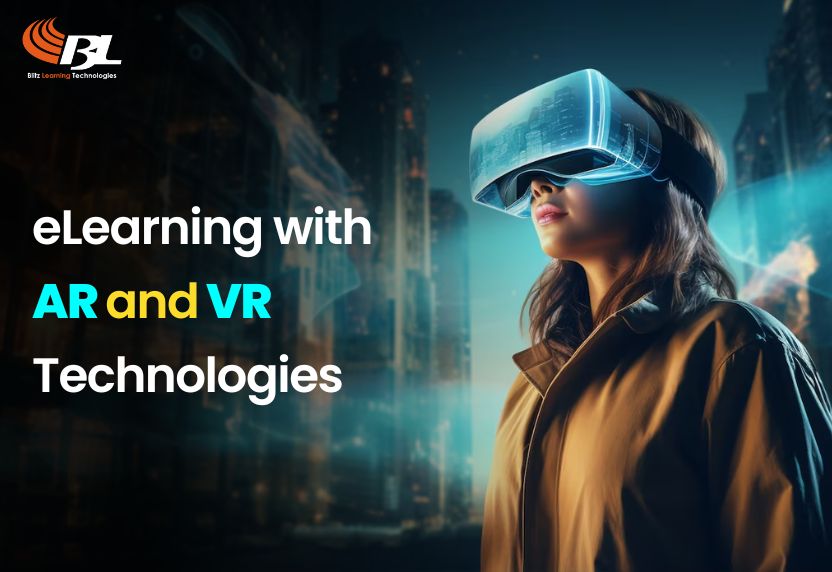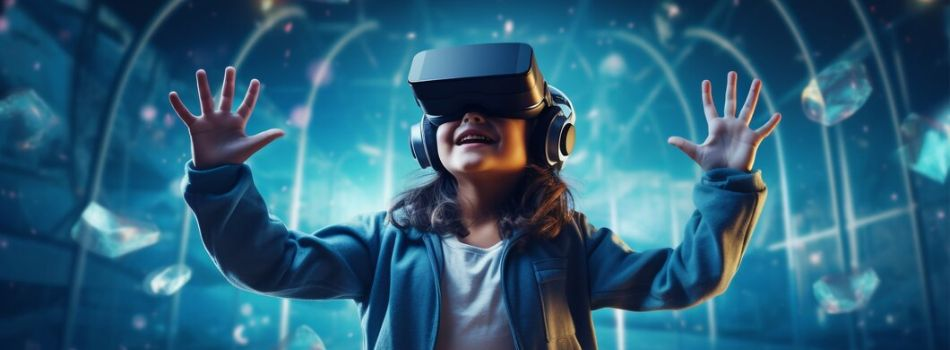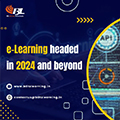
Blog
- Home
- Blog

12Jun
Transforming eLearning with AR and VR Technologies
Introduction:
The landscape of education has evolved dramatically over the years, and one of the most exciting developments in this field is the integration of Augmented Reality (AR) and Virtual Reality (VR) technologies into eLearning. These technologies are not just enhancing the way information is delivered; they are transforming the entire learning experience. AR and VR bring immersive, interactive, and engaging elements into education, making learning more effective and enjoyable. This blog explores how AR and VR are revolutionizing eLearning, the benefits they offer, and the potential challenges that come with their implementation.
Understanding AR and VR in Education
Augmented Reality (AR) overlays digital information onto the real world, enhancing the user's perception of their environment. In the context of eLearning, AR can be used to provide additional information and interactive elements to physical objects, such as textbooks, models, or even the classroom itself.
Virtual Reality (VR), on the other hand, creates a completely immersive digital environment that users can interact with, simulating real-world or imagined scenarios. VR is particularly powerful for creating experiential learning opportunities, where learners can engage in lifelike simulations that would otherwise be impossible or impractical.
The Impact of AR and VR on eLearning
Enhanced Engagement and Motivation

One of the most significant benefits of AR and VR in eLearning is the ability to capture and hold learners' attention. Traditional teaching methods can sometimes struggle to engage learners, especially in an era where digital distractions are ubiquitous. AR and VR, with their interactive and immersive qualities, make learning more engaging and enjoyable. For instance, a history lesson can be transformed into an interactive journey through ancient civilizations, or a biology class can involve a virtual dissection of a frog.
Experiential Learning and Skill Development
Experiential learning is a powerful approach where learners learn through experience and reflection. VR is particularly effective in this domain, allowing learners to practice skills in a safe and controlled environment. Medical professionals, for example, can perform virtual surgeries, gaining practical experience without the risk of harming patients. Similarly, engineering professionals can assemble complex machinery, and pilots can practice flying in various conditions, all within a virtual environment.
Accessibility and Inclusivity
AR and VR can make education more accessible and inclusive. Learners with disabilities can benefit from customized learning experiences tailored to their needs. For instance, VR can provide virtual field trips to learners who are physically unable to travel. AR can offer real-time language translations or sign language interpretations, breaking down barriers for learners with hearing impairments or language differences.
Personalized Learning
AR and VR technologies enable personalized learning experiences that cater to individual learners' needs and learning paces. Through adaptive learning algorithms and real-time feedback, these technologies can tailor the learning content for each learner, ensuring that they grasp concepts before moving on to more complex topics. This personalized approach helps learners build confidence and achieve better learning outcomes.
Collaboration and Social Learning

Despite the immersive nature of AR and VR, these technologies also support collaborative and social learning. Virtual classrooms and labs allow learners to work together on projects, conduct experiments, and engage in discussions, regardless of their physical location. This fosters a sense of community and collaboration, which are essential components of effective learning.
Challenges and Considerations
While the benefits of AR and VR in eLearning are substantial, there are also challenges that trainers and institutions must consider.
Cost and Accessibility
One of the primary barriers to the widespread adoption of AR and VR in education is the cost. High-quality VR headsets and AR devices can be expensive, and not all corporations have the budget to invest in this technology. Additionally, there may be ongoing costs related to software updates, maintenance, and training for trainers.
Technical and Infrastructure Requirements
Implementing AR and VR in eLearning requires robust technical infrastructure, including high-speed internet, powerful computing devices, and adequate storage solutions. Schools and institutions in regions with limited technological resources may struggle to implement these technologies effectively.
Content Development
Creating high-quality AR and VR eLearning content is a complex and resource-intensive process. It requires expertise in both education and technology, as well as collaboration between learners, content developers, and technology providers. Developing content that is pedagogically sound and engaging can be challenging and time-consuming.
Teacher Training and Adaptation
Trainers need proper training to effectively integrate AR and VR into their teaching methods. This includes not only technical training but also pedagogical guidance on how to best utilize these technologies to enhance learning. Teachers may need to adapt their lesson plans and teaching styles to fully leverage the potential of AR and VR.
Student Health and Safety
There are also health and safety concerns associated with prolonged use of AR and VR. Issues such as eye strain, motion sickness, and the potential for distraction need to be addressed. Trainers and developers must ensure that these technologies are used in ways that are safe and healthy for learners.
The Future of AR and VR in eLearning

Despite these challenges, the future of AR and VR in eLearning looks promising. As technology advances and becomes more affordable, the adoption of AR and VR in education is expected to grow. The ongoing development of more intuitive and user-friendly interfaces will make these technologies more accessible to both trainers and learners.
Moreover, the rise of artificial intelligence (AI) and machine learning will further enhance the capabilities of AR and VR in education. AI can provide more sophisticated adaptive learning experiences, while machine learning algorithms can analyze student data to offer personalized recommendations and feedback.
Conclusion:
AR and VR technologies are transforming eLearning by making education more engaging, experiential, and accessible. They offer new opportunities for personalized learning, skill development, and collaboration, while also presenting challenges that need to be addressed. As these technologies continue to evolve, they hold the potential to revolutionize the way we teach and learn, paving the way for a more immersive and effective learning experience. The future of education is bright, and AR and VR are at the forefront of this exciting transformation.

Neha Tyagi
About authorAs a Digital Tech professional with significant experience, Neha Tyagi has mastered the art of teamwork. Throughout her career, she maintains a commitment to continuous learning. Currently, Neha is delving into innovative technologies aimed at transforming businesses.



Leave a comments